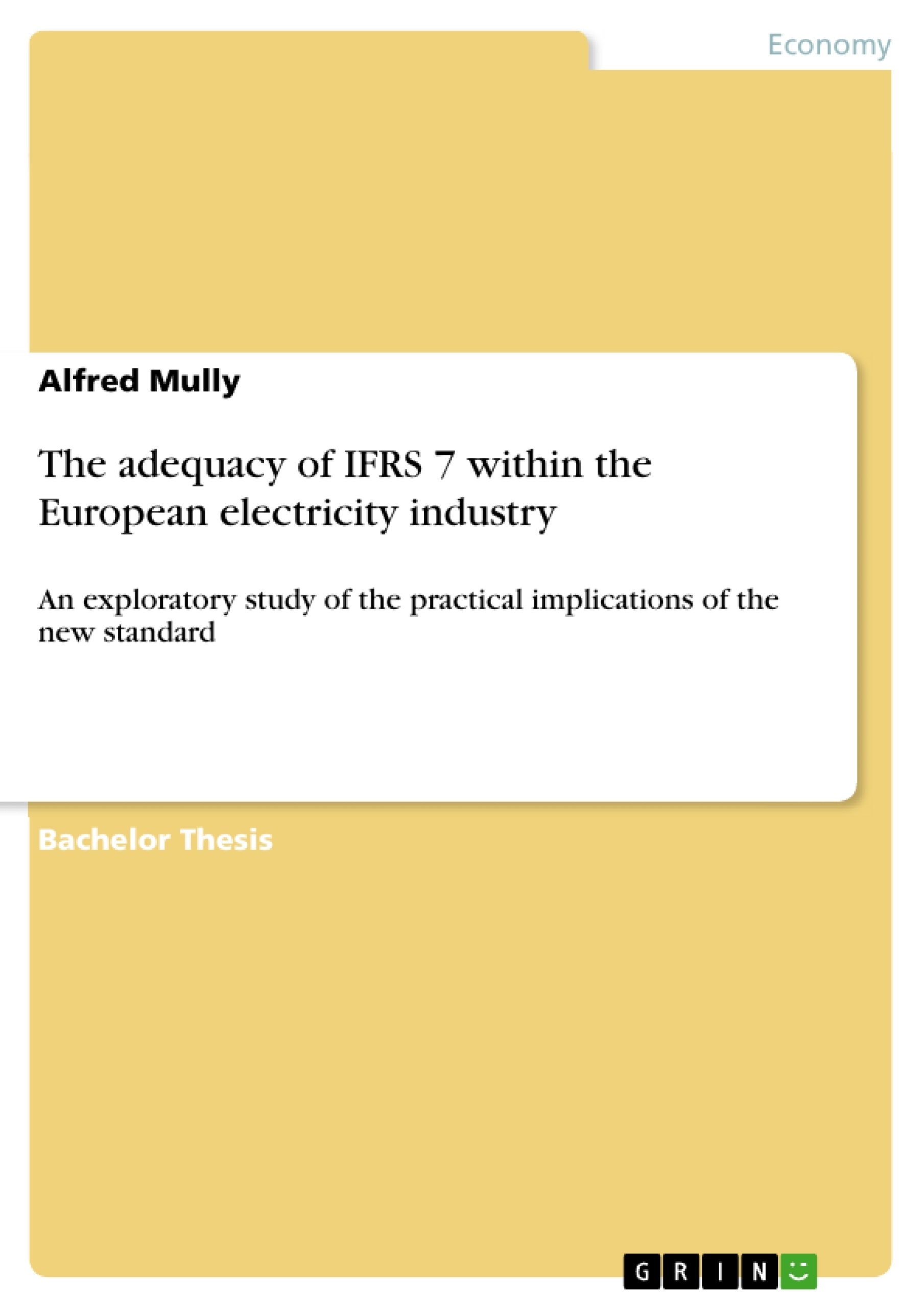This paper investigates the adequacy of IFRS 7 by measuring companies’ compliance and extent of disclosure. Adequacy is defined as: to what extent does the standard achieves its objective, which is, to require entities to disclose certain information associated with the use of financial instruments. For this purpose, the annual reports of 21 European electricity companies with fiscal years ending December 31, 2007 have been examined. The author constructed an unweighted disclosure index of 103 items, based on the IFRS 7 requirements, for quantifying the extent of disclosure. The results suggest that the sample companies varied in disclosure levels. Certain required disclosures were sometimes not provided. For instance, the majority of the sample companies provided quantitative disclosures of market risk; however the market risk measurement models are insufficiently explained. The limitations inherent to the models used were usually not discussed. Further, the results show that electricity companies were not keen on providing additional disclosures. This study also seeks to find associations between the extent of disclosure and some corporate characteristics of which statistical relationships were found in prior literature, such as corporate size, listing status, profitability, leverage and auditor size. However, this ended up without any significant findings. This is likely due to the sample size which is inappropriate for statistical testing. Finally, the paper concludes that the shortcomings in disclosure call for regulation. It is expected that, if no regulation were in place, little would be disclosed with respect to risk associated with the use of financial instruments.
Inhaltsverzeichnis (Table of Contents)
- Introduction
- Understanding IFRS 7
- The IASB in general and its Standards
- IFRS 7 Financial Instruments: Disclosures
- IFRS 7 gap analysis
- The expectations regarding IFRS 7
- The electricity industry
- The business model for electricity utilities
- Accounting for commodity contracts
- The relevance of IFRS 7 for electricity companies
- Literature Review
- The demand for and supply of disclosures
- Corporate characteristics and disclosure levels
- Prior risk disclosure studies
- Regulation of disclosure
- The need for regulation
- Extent of regulation
- Summary
- Research Design
- Sample
- Measuring the extent of disclosure
- Reliability and validity issues
- Mapping the way of disclosure
- Findings
- Overall findings
- Specific areas of attention
- Credit risk disclosures
- Liquidity risk disclosures
- Market risk disclosures
- Additional risks disclosed
- Own use disclosures
- Factors affecting disclosure levels
- Listing status
- Auditor's size influence
- Corporate size, Leverage and Profitability
- Disclosure level and the extent of derivatives' use
- Conclusion and Discussion
- Conclusions
- Limitations and Further research
Zielsetzung und Themenschwerpunkte (Objectives and Key Themes)
This paper examines the adequacy of IFRS 7 by analyzing companies' compliance and the extent of disclosure. The main objective is to determine how effectively the standard achieves its goal of requiring entities to disclose certain information related to the use of financial instruments. This study focuses on the European electricity industry. The key themes are:- The extent of disclosure of financial instrument-related information by European electricity companies in accordance with IFRS 7.
- The influence of corporate characteristics, such as size, listing status, profitability, leverage, and auditor size, on the level of disclosure.
- The identification of specific areas where disclosure is lacking or insufficient.
- The potential need for regulation to encourage greater disclosure and improve the adequacy of IFRS 7.
- The assessment of the impact of IFRS 7 on the European electricity industry.
Zusammenfassung der Kapitel (Chapter Summaries)
- Introduction: This chapter introduces the research topic, which is the adequacy of IFRS 7 in the European electricity industry. The objective of the research is stated, along with the specific research questions to be addressed.
- Understanding IFRS 7: This chapter provides a comprehensive overview of IFRS 7, including its background, purpose, and key disclosure requirements. It explains the role of the IASB and how IFRS 7 fits into the overall framework of accounting standards.
- The electricity industry: This chapter delves into the characteristics of the European electricity industry, highlighting the specific challenges and complexities that arise in accounting for financial instruments in this sector. It examines the business models of electricity utilities, the nature of commodity contracts, and the relevance of IFRS 7 for companies in this industry.
- Literature Review: This chapter reviews existing literature on disclosure practices, including studies on the demand for and supply of disclosures, corporate characteristics affecting disclosure levels, and prior risk disclosure studies. It also examines the role of regulation in promoting disclosure.
- Research Design: This chapter outlines the methodology employed in the study, including the sample selection, the measurement of disclosure, and the techniques used to analyze the data.
- Findings: This chapter presents the empirical findings of the research, analyzing the extent of disclosure by European electricity companies, identifying specific areas of attention where disclosure is lacking, and exploring the relationship between disclosure levels and corporate characteristics.
Schlüsselwörter (Keywords)
The main keywords and focus topics of this study are IFRS 7, disclosure, financial instruments, European electricity industry, risk disclosure, corporate characteristics, regulation, and adequacy. The research explores the practical implications of IFRS 7 for electricity companies, analyzing the extent of disclosure, the influence of corporate factors, and the potential need for regulatory intervention to ensure greater transparency and risk management in this industry.- Citation du texte
- Dr Alfred Mully (Auteur), 2008, The adequacy of IFRS 7 within the European electricity industry, Munich, GRIN Verlag, https://www.grin.com/document/267062



